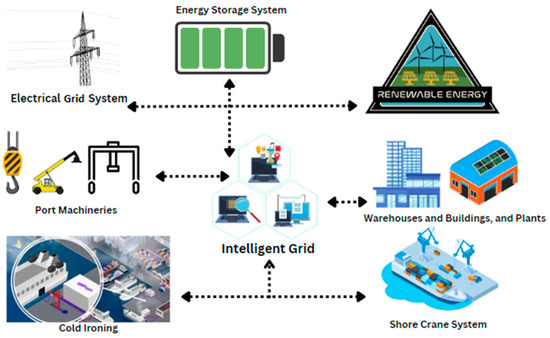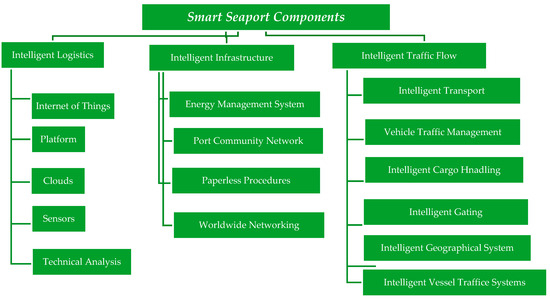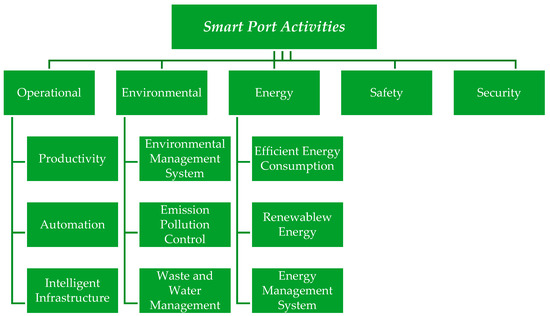To lessen the environmental impact of the maritime industry, ports must decarbonize in conformity with various standards such as the European Green Deal and the Sustainable Development Goals (SDGs). In this regard, they must demonstrate integrated low-emission energy production, distribution, and supply, as well as sustainable alternative infrastructure for refueling ships, cargo handling equipment, and other vehicles inside port boundaries. To address this issue, ports must progress toward smartening their operations. This requires intelligent infrastructure and components, with smart energy infrastructure being one of the most crucial ones. It is a part of port energy management systems (EMSs) and works based on modern technology to balance energy demand, distributions, and supply while transitioning to renewable energies.
- smart seaport
- carbon footprint
- sustainability
- energy management systems
- intelligent energy infrastructure
1. Introduction
2. Smart Seaport Components
Considering studies due to the nature and performance of the port, a smart port has three intelligent sectors: intelligent logistics, intelligent infrastructure, and intelligent traffic. Each of these sectors can be further divided into smaller intelligent components, including intelligent management, intelligent transportation, intelligent economy, intelligent energy, intelligent communication, an intelligent energy network, intelligent buildings, intelligent workforces, etc. Additionally, enhanced port resilience and operations lead to a steady and guaranteed development and safe and secure port operations [2]. Figure 12 displays the three mentioned core sectors of a smart port, as well as their subcategorization [5]. A port can only function well when the three sectors cooperate effectively. This tresextarch study later examines how these three parts may be branched. According to Figure 12, the intelligent logistics sector in the smart port consists of the internet of things (IoT), platforms, clouds, sensors, and technical analysis. This sector serves as the brain of the whole system, directing all other components to operate as efficiently as possible. The major components of the smart port infrastructure are the EMS, port community network, paperless processes, and global networking, which are four fundamental sectors that operate in a loop to improve port performance. Finally, as a transportation node, a smart port must have intelligent traffic flow, which is divided into land-based traffic and maritime-based traffic and consists of intelligent transport (land-based), intelligent cargo handling, vehicle traffic management systems, intelligent gating, and intelligent vessel traffic management systems. On the other hand, according to research by Makkawan et al., a smart port is a step up from being a digital port. This means that a smart port is a port that can manage its entire operation through intelligent components that cause a smartening procedure and can subsequently provide efficiency in fuel consumption that leads to sustainability [8]. According to this viewpoint, the process of smartening a port may be as depicted in Figure 23, which can optimally contribute to the global supply chain. Furthermore, according to other studies, smartening is a phase that precedes digitalization, which in turn leads to the digital supply chain in Industry 4.0, and preparing the digital supply chain is necessary to achieve sustainability, which is one of the primary goals of creating smart seaports [9].3. Smart Port Activities
On the other hand, the aspects of duties carried out by each smart port, however, may be divided into the following groups, as illustrated in Figure 34. Mentioning these aspects highlights the significance of current smart energy infrastructures because all components require the use of energy, and the energy supply chain undoubtedly has a significant impact on how each component operates. On the other hand, it appears that there is no other way to control energy use without making it more intelligent [2]:- (i)
-
Operation;
- (ii)
-
Environment;
- (iii)
-
Energy;
- (iv)
-
Safety;
- (v)
-
Security.
-
Operation. The operation can be categorized as follows:
- (a)
-
Productivity: this may be represented by balancing needs and providing essential port services, such as cargo loading and unloading, cargo movement inside the port, traffic density management, and port clearance operations [10].
- (b)
-
Automation: under their supervision, different techniques for replacing human labor with automation may improve service effectiveness and reduce waiting times [11].
- (c)
-
Intelligent infrastructure: this refers to utilizing an intelligent port’s departments, capable of intelligent collaboration via intelligent communication and IoT [1].
-
Environment. The following categories apply to the environment:
- (a)
-
Environmental management system: this domain may be used to demonstrate any action that helps port activities fit with managing environmental protection [2].
- (b)
-
Emission and pollution control: this refers to any national and international regulations-compliant actions taken to reduce and control emissions within the port territory under the supervision of port authorities or public authorities [7].
- (c)
-
Waste and water management: this comprises all actions for balancing supply and demand for the management of water, a resource that is essential to the planet, and then goes to managing and accepting waste materials and then utilizing them, if possible, for other sectors like renewable energy [12].
-
Energy. This can be divided into:
- (a)
-
Efficient energy consumption: to achieve optimal energy consumption in seaports, there are several guidelines and international and national rules relating to the efficient energy usage of ships, vehicles, equipment, buildings, industries, and generators [13].
- (b)
-
Renewable energies and their production: Preparing renewable energy sources for use at seaports, such as wind, solar, earth thermal, and marine energy, is the second stage in minimizing the usage of fossil fuels. This might be one of the main objectives of smart seaport authorities and policymakers [14].
- (c)
-
Energy management: all tasks and duties the port authorities have to do with creating port-wide plans for energy efficiency and other relevant things [2].
-
Safety. In smart seaports with intelligent infrastructure, all port safety operations must be monitored [15].
-
Security. The term “smart port security activities” refers to all programs, projects, and seaport security operations that demand sophisticated infrastructure, technology, and oversight [16][17][16,17]. And now, with the deployment of artificial intelligence (AI) and intelligent energy network systems for smartly enhancing and controlling ports, cyber security is one of the most essential operations in the field of port security [18].
4. Smart Port Management
The implementation of smart energy infrastructures is closely tied to the integration of intelligent management systems in ports. These management systems, powered by innovative technology, allow for optimal resource allocation while optimizing energy consumption and cargo handling procedures. In tandem, intelligent energy infrastructures complement these efforts by delivering renewable and cost-effective power sources, thereby improving the overall operating efficiency. The interplay between intelligent port management and smart energy solutions promotes sustainability and competitiveness in the maritime industry [20]. Then, in this regard, and according to another perspective, each smart port has an intelligent management system that guides its initiatives, operations, and policies. Each smart port contains components that work together to produce an intelligent form and sensible approach, as was previously indicated. The smart port management system consists of intelligence in vessel traffic, cargo handling, port administration, energy, and resources [15]. Figure 45 depicts the critical components of a smart port management system.- -
-
All vessels in the port area may have vessel traffic management (VTM), vessel traffic management services (VTMSs), pilotage operation, and other maritime services managed by intelligent vessel management.
- -
-
Intelligent infrastructure and equipment may offer an intelligent cargo handling management system, including all loading, discharging, moving, and stripping storage in or out of a smart port.
- -
-
Intelligent port management uses cutting-edge decision-making processes, intelligent automation systems, and application systems for all choices, policies, and procedures.
- -
-
Intelligent energy management includes balancing energy supply and demand within the port, controlling efficient energy usage, and switching from fossil fuels to renewable and green energy sources.
5. Energy Management System
It is obvious that an EMS for seaports must be based on collaborating and integrating all their components in a continuous loop to achieve the best performance when all issues regarding smart seaport components, smart port duties aspects, and intelligent port management are considered. Figure 56 depicts the main responsibilities of the EMS in smart ports, demonstrating that smart energy infrastructure is a crucial component that relates to all of them. Responsibilities may change depending on the design and type of port activities [22]. Figure 56.
Figure 56.6. Energy Intelligence Network
The intelligent energy network is the first and most vital component of an EMS, which composes smart energy infrastructure. It enables EMSs to find high-caliber, appropriate production and storage units more easily. It frees stakeholders and policymakers to focus on finding the best conditions for using electrical energy and serving consumers [23][28].This change emphasizes intelligent, economical, environmentally beneficial, and creative electrical system solutions [24][29].Figure 68 shows how an intelligent energy network may improve the efficiency and dependability of the power system by combining a variety of local and renewable energy sources [25][27]. The layout of the energy intelligence network in the smart seaport, based on [27].It provides a cargo terminal with buildings, an onshore power supply, an in-port crane, stowage equipment, and cranes for handling products, as well as an intelligent energy network layout at the smart seaport.
The layout of the energy intelligence network in the smart seaport, based on [27].It provides a cargo terminal with buildings, an onshore power supply, an in-port crane, stowage equipment, and cranes for handling products, as well as an intelligent energy network layout at the smart seaport.7. Virtual Power Plant
The growing use of distributed generation (DG) and the absence of a passive perspective emphasize the need for long-term investments in DG governance. As a result, creating a framework that makes DG’s engagement in the energy sector easier is urgently required [26][33]. The term Virtual Power Plant (VPP) in a smart port refers to a centralized system that integrates and controls a variety of distributed energy resources, including solar cells, wind turbines, and batteries, to optimize energy generation and distribution and increase the energy efficiency and resilience of the port. VPP is not a real power plant, despite being defined as “a unique power station that leverages ICT to connect, monitor, and display remote generators”, and it is a digital platform that aggregates and controls distributed traditional or renewable energy resources, batteries, and demand–response devices to maximize their collective power output and consumption, hence improving network stability and efficiency [27][34]. Electricity may be moved between different units under the direction of a VPP. It may increase system effectiveness and optimize energy use [28][35]. VPPs are charged with three primary functions, each of which is significant in and of itself: organization and control, distribution and optimization, and a mix of distributed generation and renewable energy sources [29][36]. The next DER component is ICT, which is a collaborative component between the IoT and intelligent energy networks.8. Information and Communication Technology
The term ICT in smart ports refers to the integration and application of ICT solutions, such as digital systems, data analytics, sensors, and communication networks, to improve the effectiveness, security, and sustainability of port operations and management. This makes it possible for the maritime industry’s logistics, cargo handling, and overall performance to be optimized [30][37]. ICT is needed to create protocols that allow real-time producer–user interactions in an intelligent energy network as well as to provide a practical, flexible, and secure communication infrastructure [30][37]. According to a study by Kara in 2020, ICT is now one of the primary and essential elements of the 5th and 6th generation of seaports, and data integrated with IoT will be sent through different programmed transmitters and receivers like personal telephones [31][38]. Additionally, to better present the model of the smart port system, a design was made according to a study by Douaioui in 2018; based on this study, the ICT-based smart port system consists of two pillars that include different components based on the viewpoint of using ICT as a technological and digital part of smart ports. These pillars are connectivity and automation [32][39]. An ICT-based smart port is “a technologically enhanced marine facility that optimizes its entire operations by using ICT”. It combines sensors, automation, and data analytics to improve efficiency, safety, and sustainability in areas such as cargo handling, security, and energy management, ensuring marine competitiveness and environmental responsibility [33][40].




